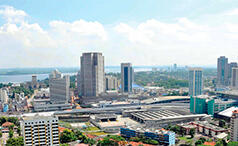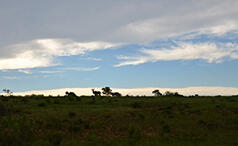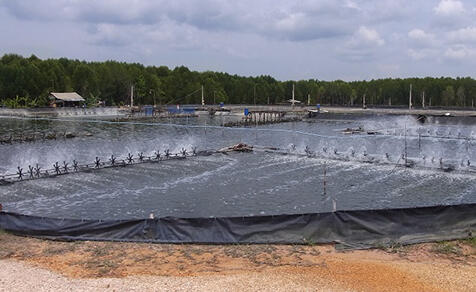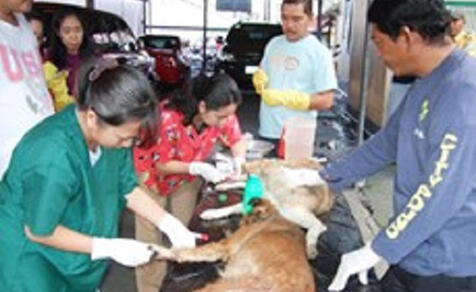Utilize Renewable Geothermal Energy for a Low-carbon Society
Utilize Renewable Geothermal Energy for a Low-carbon Society
Research Fields and Areas
Environment/Energy (Carbon Neutrality)
Indonesia has a population of over 200 million, and a massive demand for electricity. Decarbonization is a national policy objective, and the country hopes to make use of geothermal energy as a renewable energy source associated with Indonesia's large number of active volcanoes. One difficulty with this approach has been the requirement for large-scale test drilling to find locations underground that have an abundance of geothermal energy resources.
Such drilling involves a large initial investment and has a high risk of failure, and as a result, geothermal power generation did not grow as fast as originally expected.

Geothermal energy is a renewable energy that does not produce greenhouse gases. Moreover, it can provide a more stable supply of energy than wind or solar.

Principal Researcher (Japan):Prof. KOIKE Katsuaki
Graduate School of Engineering, Kyoto University
 Advantage of Joint Research
Advantage of Joint Research
Indonesia conducts a great deal of research in the field of geothermal energy research. Partnering with Institut Teknologi Bandung (ITB), where there were already many projects involving groups of Japanese researchers, provided the opportunity to train young researchers and to make advances in globalization of research. Use of turbines in geothermal energy projects may also lead to future business for Japanese companies.

Principal Researcher (Indonesia):Prof. Sudarto Notosiswojo
Faculty of Mining and Petroleum Engineering, Insitut Teknologi Bandung (ITB)
 Advantage of Joint Research
Advantage of Joint Research
Developing technology for identifying steam spots has resulted in progress in geothermal energy exploration. This provides a means of meeting predicted growth in energy consumption. In addition to helping to keep down greenhouse gas emissions, the research has led to training new researchers, and has greatly enhanced ITB's research potential by making a substantial upgrade to research facilities.
Project summary
Technology developed for precise identification helps cut initial costs
Identifying locations suitable for geothermal energy production usually requires deep drilling, incurring high initial costs. Moreover, test drilling sometimes fails, and the combination of high initial costs and large operating risk meant that new exploration had not made much progress. This project combined remote sensing techniques with geochemistry and mineralogy techniques to develop technology that could identify optimal locations (steam spots) for geothermal energy production with greater precision. The aim was for technology that cut both initial costs and operating risk, thereby contributing to the progress of geothermal exploration in Indonesia.
Optimization systems help ensure long-term use of geothermal energy
The project developed technology for precisely identifying optimal locations (steam spots) for geothermal energy production. This reduces the number of exploratory drillings required, which can cut initial costs. The project also developed environmental monitoring technology that enables use of geothermal energy in harmony with the environment, and optimization systems that help to ensure that the geothermal energy can continue to be used in the long term. These technologies make it possible to increase the proportion of Indonesia's energy provided by geothermal energy sources, which can help to meet the country's expected growth in demand for energy, and can potentially help to achieve large cuts in carbon dioxide emissions.

Hot water/gas analysis 
Analyzing isotopes and temperatures of hot water and gas components reveals properties such as the source, flow path, residence time, and reservoir temperature.
Project Topics
Equipment provision
As part of the project we deployed twelve different types of stateof-the-art measurement/analysis equipment, including scanning electron microscope and chromatographs and three types of software. These are in full use. In addition to their use by ITB, they handle requests for analysis from other entities, including universities and research institutes throughout Indonesia, and police and customs agencies. Costs of consumables and maintenance are secured by ITB, and the instruments are kept ready for use at all times.
Training human resources in partner country
In order to train people to handle geothermal exploration in Indonesia, a broad range of training is provided, including inviting over ten Indonesian trainees to Japan each year, including ITB graduate students, young researchers, and young private sector engineers. In addition to classroom learning, trainees get practical training through field surveys in Oita Prefecture, practice analyzing samples, and give presentations of their results.
Private sector collaboration
Tie-ups with a number of companies in the partner country led to jointly-conducted field survey results being published in international journals, and to locations pinpointed by the project being adopted as new drilling sites. During the project, we were also able to extend the research to other districts, providing additional sites for verifying the accuracy of steam spot detection, and making it easier to implement our research outcomes in society. Japan-side companies also helped us to resolve a number of problems concerning geothermal energy exploration and cooperated in numerical simulations, etc.
Ganesa Wirya Jasa Adiutama (The prize of Insitut Teknologi Bandung)

ITB's highest-ranking award. In presenting the award, ITB valued the implementation of joint research over long years, and gave a particularly high rating to the big upgrade in research equipment, the substantial enhancement in research capacity through training, and to the way that the project has been steadily producing results right from the start.
Partner country principal investigator's comments
The aim of the BAGUS project was to reduce costs and reduce the risk of failed exploration in order to realize relatively inexpensive but precise technology meeting the needs of geothermal resource exploration in Indonesia.
By means such as introducing state-ofthe-art experimental equipment and software, the activities of the BAGUS project have led to the development of science and technology, the enhancement of exploration techniques, and of course, training of ITB people. The people who have been trained are now working as engineers or as university teaching and research staff in the field of geothermal energy.




I already had strong links with Institut Teknologi Bandung (ITB) in resources engineering and earth science, and four of the teaching staff at ITB gained their doctorates under me. The first collaborative research began in 2004 with a geostatistical assessment project of coal resources, and the relationship has grown since then, including collaboration in conference organization and jointly-authored papers. After hearing that a proposal from the same department as me in Kyoto University had been selected as a SATREPS project, this joint research project was planned and proposed, aiming to deepen a joint research on sustainable energy, and to boost the strength of research at ITB through an initiative taking a comprehensive approach to geothermal energy research.



When we started organizing the project, communication with the ITB side was almost completely based on email. But with email, it was difficult to discuss things in depth, and everything took a long time. Convinced that direct meetings were important for reaching a consensus, soon after provisional selection was announced, we invited the key ITB members to Kyoto University to discuss research objectives, content, schedule, equipment and software required, and the outcomes that we hoped to obtain. We conducted the discussion of these and other topics over two full days that were packed with meetings.
After that, we kept in close contact, giving full respect to each other's culture, including ensuring that schedules took the partner's regular events and customs into account. This approach ensured that the research proceeded on schedule, and was vital in ensuring that we were able to achieve the outcomes on time.


In addition to promoting geothermal energy production and fulfilling our mission of contributing to low carbon society, arranging for joint researchers from Indonesia and other countries to conduct research in collaboration with Japan is boosting networking between researchers and strengthening alliances. We hope to develop this project into world-leading research. The outcomes obtained by the SATREPS project will provide a foundation for extending both the research and research networks through initiatives such as the development of technology for exploring deeper parts of reservoirs to enable an increase in the generating capacity in districts that have already been explored. They also provide a foundation for further joint research with Egypt, Mozambique, and other countries.

-

The official logo for project
The nickname "BAGUS" is an Indonesian phrase meaning "Very Good." 

Environment/Energy (Carbon Neutrality)
 Indonesia
Indonesia
Case Studies
Contact Us
Japan Science and Technology Agency (JST)
Department of International Affairs
SATREPS Group
TEL : +81-3-5214-8085
Related articles
-
Environment / Energy
(Carbon Neutrality)
 Malaysia
Malaysia
For a future in which people can live with peace of mind
- Developing scenarios for creating low-carbon societies - -
Environment / Energy
(Climate Change)
 Republic of South Africa
Republic of South Africa
"Artificial Earth" Offers Seasonal Climate Predictions a Year in Advance
- The irreplaceable Earth "simulated" by computer - -
Bioresources

 Kingdom of Thailand
Kingdom of Thailand
Improved aquaculture technology will save the world!
- Turning Southeast Asia into a world food storehouse - -
Infectious Diseases Control

 Republic of the Philippines
Republic of the Philippines
Saving humanity from leptospirosis
- Battling infectious disease with vaccines and diagnostic technology -
















